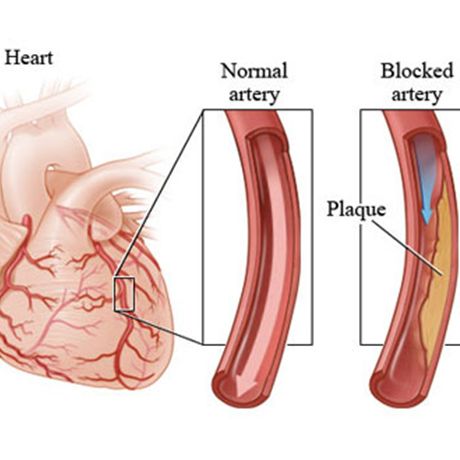The cardiovascular system is complex and has many working parts. The heart is the main source of power within the cardiovascular system, circulating blood throughout the body and allowing for oxygen and nutrients to reach tissues. A healthy heart beats an average of 100,000 times per day. The right side of the heart pumps blood to the lungs so that the red blood cells can exchange carbon dioxide (CO2) waste for oxygen (O2). The left side of the heart pumps blood to the head and body.
A heart that is functioning properly has its own electrical system of atrioventricular nodes (AV nodes) that controls the nerve impulses that signal the heart muscle to contract. When the heart does not work properly, a person may have a cardiovascular disease.
Coronary artery disease
Coronary artery disease is a disease in which plaque builds up on the insides of the heart's arteries. This can restrict blood flow to the heart and lead to heart attack. Risk factors include high blood pressure, family history of coronary artery disease, smoking, diabetes, and increased age in men and women.
Arrhythmias
If the atrioventricular nodes of the heart are not working properly, the heart will beat irregularly; this type of cardiovascular disease is called an arrhythmia. These electrical impulses can be seen on an electrocardiogram (EKG or ECG) and typically follow a particular pattern known as the PQRS wave.
- Tachycardia is when the heart beats faster than normal
- Bradycardiais when the heart beats more slowly than normal
- Atrial fibrillation is when an upper chamber of the heart beats at the wrong time
Risk factors for arrhythmias include previous damage to the heart (possibly from heart attack or heart failure), use of alcohol and other drugs, and irregular concentrations of some minerals like potassium, magnesium, and calcium.
Heart Failure
The term heart failure is used any time the heart is not pumping blood as efficiently as it should. Heart failure can be caused by a number of things. Congestive heart failure is caused by a build-up of fluid around the heart, preventing it from being able to adequately expand and contract. Another form of heart failure occurs when a chamber (or chambers) of the heart enlarges, which results in the heart having a volume of blood that is too large to effectively pump to the lungs or throughout the body. When this happens, the heart muscle grows and becomes larger to compensate for the increase in blood volume that passes through its chambers. The heart will also compensate by pumping faster. All of these adaptations allow the heart to pump blood adequately at first, but eventually the heart muscle can no longer keep up and begins to wear out. Risks for heart failure include other heart diseases and high blood pressure.
Visualizing heart disease
Essential question: What is normal cardiac anatomy and physiology?
Objective: Students will differentiate normal and diseased cardiovascular anatomy and physiology.
Match the following images to the correct cardiovascular disease. Describe the disease indicator in detail. Images will only be used once.
 | Heart failure |
 | Coronary artery disease |
 | Arrhythmia |
Match the following EKG strips with the correct form of arrhythmia. Use the normal EKG image to make your comparisons. Describe the EKG anomaly in detail. Images will only be used once.
| Normal |  |
| Normal |  |
| Tachycardia |  |
| Bradycardia |  |
| Atrial fibrillation |  |
Answers
 | Coronary artery disease |
 | Arrhythmia |
 | Heart failure |
| Normal |  |
| Tachycardia |  |
| Bradycardia |  |
| Atrial fibrillation |  |
 The cardiovascular system is complex and has many working parts. The heart is the main source of power within the cardiovascular system, circulating blood throughout the body and allowing for oxygen and nutrients to reach tissues. A healthy heart beats an average of 100,000 times per day. The right side of the heart pumps blood to the lungs so that the red blood cells can exchange carbon dioxide (CO2) waste for oxygen (O2). The left side of the heart pumps blood to the head and body.
The cardiovascular system is complex and has many working parts. The heart is the main source of power within the cardiovascular system, circulating blood throughout the body and allowing for oxygen and nutrients to reach tissues. A healthy heart beats an average of 100,000 times per day. The right side of the heart pumps blood to the lungs so that the red blood cells can exchange carbon dioxide (CO2) waste for oxygen (O2). The left side of the heart pumps blood to the head and body.












































0 Comments: